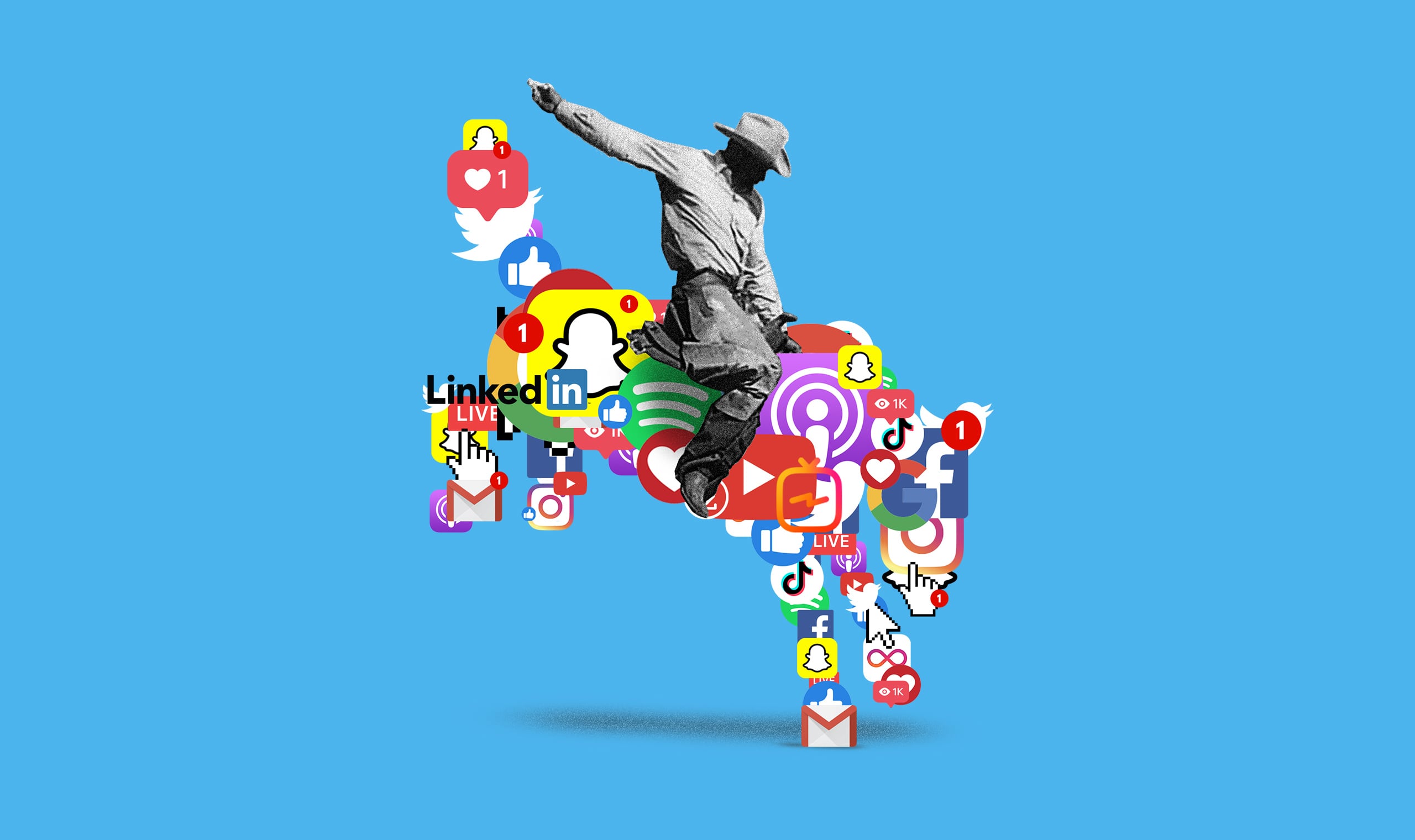Beyond the Blog: Harnessing the Power of a Platform

The formative growth of the internet and the rise of social and digital platforms are a vast infrastructure project designed to deliver information. The foundation created over the last two decades has been the catalyst for a new age of publishing. It’s a generational paradigm shift that has removed the traditional gatekeepers that have long controlled what is released to the public while democratizing the tools of creation to make production attainable for anyone. This has allowed for content to be created with a volume, frequency and authenticity that are unprecedented in history. Right now, on TikTok, a teenage dancer has built a following of over 68 million fans—numbers that brands used to pay a small fortune for, she has captured on her own with her smartphone. Creators are bringing projects to market via crowdfunding and launching platforms that grow to be valuable assets with real market value.
Beyond individual creators, brands have also found new purpose and connection directly to their audience through a variety of content. What once was a blog is now a multichannel brand experience happening through editorial, podcasts, videos and often real-life experiences that the audience is capturing and sharing back with the brand. All of this is done by embracing the notion that content marketing is more than a single activation: It’s a coordinated platform for brands to communicate from.
Why a publishing platform?
Control Your Own Narrative. We live in an age that is both awash in information and starving for it. With so many voices speaking in digital channels, it’s easy for someone else to define a brand if there is no communication to steer the conversation and reinforce the values behind it. A brand can lose control of its own story, leaving it to be defined by the whim of the internet. Creating a platform allows for the creation and dissemination of a steady stream of storytelling content that allows a brand to control its own narrative while engaging and building an audience of like-minded people.
A platform extending over multiple touchpoints allows a brand to keep people’s attention at a time when everything is trying to steal that attention away.
Build an Audience. This is an essential part of building a publishing platform. Providing quality, useful content with the audience in mind is the critical first step. The content could be educational, entertaining or aspirational—whatever is right for the audience and authentic for the brand. Adding value to the lives of the audience will bring them back for more and form a valuable relationship over time. This growing and dedicated audience adds tangible value for a brand both from a marketing perspective and as a potential revenue stream. The size of the audience is not as important as its dedication to the brand.
Stay Relevant. Because we are saturated with information and living in a world full of pandemics, politics and murder hornets, it’s honestly harder than ever to break through the noise. If brands aren’t communicating with their audiences, those audiences will move on and potentially be caught by something new. A platform extending over multiple touchpoints allows a brand to keep people’s attention in a time when everything is trying to steal that attention away.
What’s a brand publishing platform?
First, let’s really define it: A brand publishing platform is ongoing content living across multiple channels and audience touchpoints, growing and expanding organically as needed to build branded narratives. Such a foundation of two-way communication allows the brand to expand on and capture audiences around products, services and ideas that are at the brand’s core. Treating your brand as a media publisher creates more control over those narratives, and has the potential to create more value exchange with audiences and more cultural relevance for the brand that many traditional advertiser-level engagements simply can’t replicate.
As an example, this article is part of Truth Collective’s brand-publishing platform, Higher Order. The platform started as an editorial blog and email program but has grown to include a podcast (subscribe today!) and a print magazine. Each extension allows for a slightly different exploration of our core theme of “noble ambition.”
A brand-publishing platform is ongoing content living across multiple channels and audience touchpoints, growing and expanding organically as needed to build branded narratives.
Let’s explore a few brands and how they have created platforms of their own. Vans is an exciting brand to study as an apparel company focused on selling clothes and shoes to a worldwide audience dedicated to a progressive sports lifestyle. Their content, whether through their website, video series, music projects on Spotify, social channels or their films division is designed to sell that lifestyle to their audience every day, even when that audience is not currently in the market to buy.
They present themselves not just as a leader but as the maker and curator of the culture their audience loves. In many ways their products become almost secondary. Their platform extends across multiple channels and exists off- and on-line. That focus on content is why they have gone from a niche sneaker company for skaters to a global fashion and lifestyle brand, while other brands like Vision Street Wear that launched at a similar time never attained the same level of cultural relevance.
Another example to explore is Think with Google. We all know Google; its tools are woven tightly into the fabric of our everyday lives. Because we ask Google to order us detergent, give us directions or find us reviews on the best robot vacuum, millions of users all over the world create an endless sea of data every day. Think is where that data is turned into usable insights that help marketers and others understand how consumers are using their tools. This could all be presented as boring drudgery, but it’s not. Everything is presented with design, engagement and experience at the core of the content. Think’s interactive reports make the information a pleasure to explore and read. The platform also extends into editorial content, and standalone and episodic videos, along with strong social communities engaging across channels. Think is about using its core products to generate useful content that makes audiences understand these tools and how to become experts in their use. Thus the audience can cross the chasm quicker and the technology be adopted on a mass scale faster.
It’s no surprise that Disney is a master at platform building. There are a hundred examples that could be picked from their marketing portfolio, but one of note is D23. For the last decade, Disney really focused on cultivating their fanbase with multiple platforms that are constantly bringing the brand forward to their diehard enthusiasts. D23 is their official fan club, consisting of conventions, a high-end print magazine, podcasts, videos and loads of merchandise. The more of a Disney fan you are, the more ways they have to interact with you and constantly present you with new content and opportunities to buy into their brand experience. Disney along with Apple has pioneered the hybrid event, balancing between consumers and industry insiders by marketing industry events as exclusive access for both audiences. Essentially, they have attendees happily paying to see their new product, experience and brand strategy presentations.
So why is all this valuable?
A question that often gets asked is this: Why invest in a platform that takes time and resources to build when digital and social ads are driving immediate and measurable impressions? The answer is that platform building is claiming a space for your brand’s future, not just seeking short-term KPIs. What it does for a brand is build an engaged audience of consumers and customers that become a real and valuable asset for the brand.
If your brand were a show, not here to sell but to entertain or teach, who would be watching and what would they want to see? What do you need them to see that your marketed products and services don’t immediately reveal about your brand?
A Brand Platform Also Generates Intellectual Property. Owned content with a built-in audience becomes valuable as a source of revenue. The revenue could be from advertising dollars on a podcast, selling new products associated with the platform or even the platform itself.
For example, look at actor John Krasinski’s launch of his homemade show called Some Good News during the early days of the COVID-19 lockdown. He and his network of celeb friends produced it, and it immediately went viral. At the moment when COVID-19 was driving the nation into an anxiety-laden existence, he provided what millions of viewers needed—a smile and a break from the bleak headlines and heavy news cycle. In a few short months the series garnered over 71 million views. The inherent value in that platform and its audience was recognized immediately by large brands that got involved in his content. Something that started as a short-term effort to provide a smile and spread some goodness quickly created business value as a way to connect with national and global audiences with a powerfully optimistic and authentic tone. The whole SGN platform recently sold to Viacom/CBS for undisclosed millions.
Gimlet is another success story. The company started producing podcasts at the beginning of the podcast boom. It made original programming but also produced shows for Trader Joe’s and other national brands. Over time it built a platform flush with listeners and valuable IP. To kickstart its own podcasting efforts, Spotify purchased the company and all its show titles for $200 million.
So how do you get started?
Ask yourself, “If my brand were a show, not here to sell but to entertain or teach, who would be watching and what would they want to see?” Put another way, what do you need them to see that your marketed products and services don’t immediately reveal about your brand?
From that jumping-off point, set a goal of getting started. Pick one channel to start on: a blog, a video, a podcast—whatever you can do to get started. Create a publishing schedule and promotional plan and get to work. Don’t be discouraged if it takes time to see the audience grow, but when it does, be prepared to grow into new channels as you identify opportunities.
Prioritize progress over perfection. Don’t be sidelined by inaction by overengineered planning. Telling your story and creating interaction will go a long way in launching your platform and starting more robust audience-building for your brand’s future.

